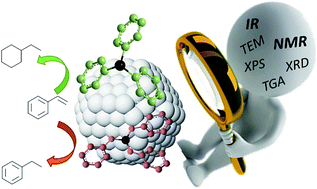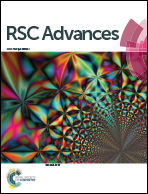Surface characterisation of phosphine and phosphite stabilised Rh nanoparticles: a model study†
Abstract
Small and well defined Rh nanoparticles (<2 nm) stabilised by the model ligands triphenylphosphine 1 and triphenylphosphite 2 were synthesised using various P/Rh ratios. In all cases, the crystalline NPs exhibited a spherical shape and a fcc structure. During the synthesis of these materials, hydrogenation and oxidation of the stabilisers take place and the degree of hydrogenation of the stabilising ligand increased when low ligand to Rh ratio is used during their synthesis. The Rh1 systems mainly contain adsorbed phosphine oxide species at their surface whereas the Rh2 systems include both phosphite and phosphite oxide species. Analysis of the surface of these nanoparticles by infrared spectroscopy revealed the presence of Rh-H at the surface of the NPs and hydride titration experiments revealed a higher hydride coverage for the phosphine stabilized systems. By CO adsorption/infrared experiments, bridging, terminal and geminal Rh(CO)2 sites were detected. All these systems were active catalysts in the hydrogenation of styrene and the observation of Rh(CO)2 sites could be correlated with the activity of these species for the hydrogenation of the aromatic ring.


 Please wait while we load your content...
Please wait while we load your content...